Location is a primary factor used in benchmarking pay rates and developing salary ranges for most nonexecutive jobs. Summary results from the Culpepper Geographic Pay Differential Practices Survey indicate how companies use geographic pay differentials to design salary programs and manage differences in pay among locations.
Key Survey Findings
The survey of primarily North American companies found that 71 percent of respondents with employees in more than one location provide geographic pay differentials or adjust pay rates based on location.
Of companies with geographic pay differentials:
- 86 percent use salary surveys (i.e., cost of labor) to determine geographic pay differentials.
- 69 percent adjust compensation by creating separate salary structures for various locations.
- 65 percent use data for individual cities to determine geographic pay differentials.
- 59 percent review their differentials annually.
Geographic Pay Differential Defined
A geographic pay differential is additional compensation paid to an employee to account for variations in cost of labor and/or cost of living between locations.
Some companies use cost of living (e.g., cost of goods and services) as a factor to determine geographic pay differentials. However, most companies use cost of labor (e.g., compensation) as the primary factor to determine pay differences among locations.
The following approaches typically are used to compensate employees for differences among locations:
- Separate base salary structures for various locations.
- Individual adjustments to base salaries.
- Supplemental geographic differential payments.
Use of Geographic Pay Differentials
Seventy-one percent of surveyed companies with employees in more than one location reported that they provide geographic pay differentials or adjust pay rates based on location (Table 1). However, as companies increase in size, they are significantly more likely to use geographic pay differentials.
Table 1: | |
All companies | 71% |
By number of employees |
|
1 to 100 | 39% |
101 to 500 | 61% |
501 to 2,500 | 72% |
2,501 to 10,000 | 73% |
Over 10,000 | 86% |
Frequency Companies Review Geographic Pay Differentials
Most companies review their geographic pay differentials annually (Figure 1).
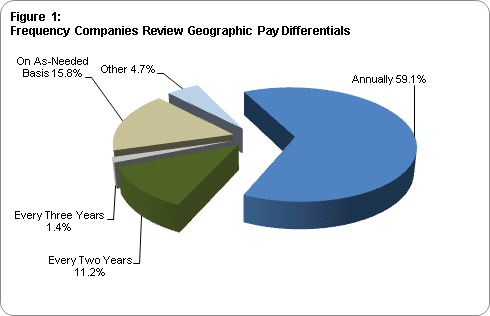
Geographic Pay Differentials by Job Level
Most companies with geographic pay differentials provide them to employees below the executive ranks. Executives are less likely to be eligible for geographic pay differentials than nonexecutive employees (Figure 2).
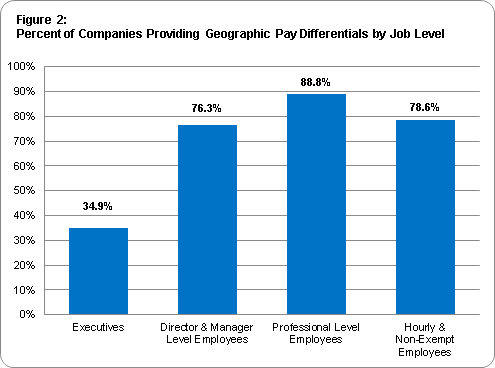
Types of Data Used as Basis to Determine Geographic Pay Differentials
More than 86 percent of companies with geographic pay differentials use salary surveys (cost of labor) to determine geographic pay differentials. Just over one-quarter of companies use cost-of-living data as a basis to determine geographic pay differentials (Figure 3).
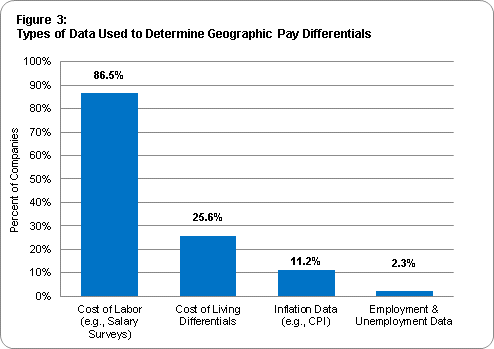
Note: Participants could select more than one data type.
However, most companies that use cost-of-living differentials also use cost-of-labor data from salary surveys. Only 6 percent of companies use cost-of-living data as their primary source to determine geographic pay differentials. At the same time, more than 75 percent of companies that reported using two or more types of data use cost-of-living differentials.
Methods to Assign Locations to Geographic Pay Differentials
Nearly two-thirds of companies with geographic pay differentials use data for individual cities to assign locations to geographic pay differentials (Figure 4).
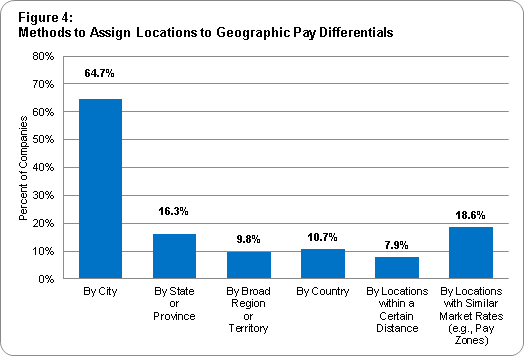
Note: Participants could select more than one method.
Market pricing jobs by city is widely considered a best practice for assigning locations to geographic pay differentials. However, it is not always practical or possible to use market data for city locations.
As an alternative, just over 16 percent of companies create geographic pay differentials using a particular state or region, while almost 19 percent of companies create geographic pay differentials by grouping locations with similar market rates (e.g., Geographic Pay Zones).
Approaches to Adjust Pay Based on Geographic Pay Differentials
Almost 69 percent of companies with geographic pay differentials adjust compensation by creating separate salary structures for different locations (Figure 5).
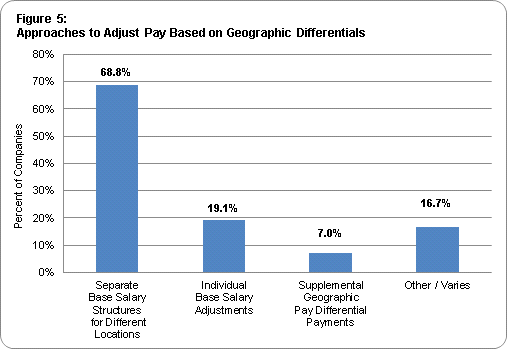
Note: Participants could select more than one approach.
Data source: Culpepper Geographic Pay Differential Practices Survey of 304 participating organizations.
Survey dates: Oct. 12, 2010 through Dec. 30, 2010.
Country location of participating companies: United States: 92 percent; Canada: 5 percent; other: 3 percent.
Culpepper and Associates conducts worldwide salary surveys and provides benchmark data for compensation and employee benefits programs.
Source: The Culpepper e-Bulletin, March 2011, www.culpepper.com.
Reposted with permission.
Quick Links:
- SHRM Online Compensation Discipline
- SHRM Salary Survey Directory
- SHRM Compensation Data Center
- SHRM Metro Economic Outlook reports
• Sign up for SHRM’s free Compensation & Benefits e-newsletter |
An organization run by AI is not a futuristic concept. Such technology is already a part of many workplaces and will continue to shape the labor market and HR. Here's how employers and employees can successfully manage generative AI and other AI-powered systems.



